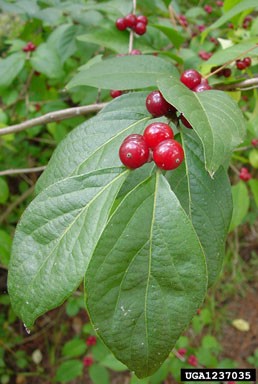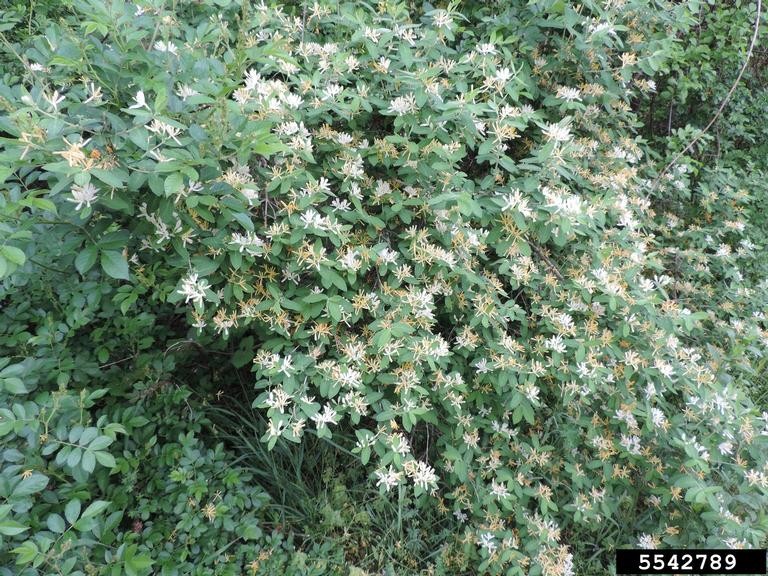Amur Honeysuckle
Amur honeysuckle (Lonicera maackii), often called bush honeysuckle, was introduced to North America from Asia in 1898. It was initially valued as an ornamental shrub, for wildlife cover, and for controlling soil erosion. However, its hardiness and rapid growth allowed it to escape cultivation and spread into natural habitats.
The presence of Amur honeysuckle causes substantial ecological disruption. It aggressively forms dense thickets that create deep shade, preventing the growth of native wildflowers, grasses, and tree seedlings on the forest floor.
By leafing out earlier in the spring and holding its leaves later into the fall than native plants, it gains a significant competitive advantage for sunlight and resources. This dominance severely impedes the natural regeneration of forests and displaces native plant communities.
Furthermore, while birds and other wildlife consume the shrub's abundant red berries, these fruits are low in the essential fats and nutrients that native species provide. Migrating birds, in particular, rely on high-fat fruits to fuel their long journeys. The carbohydrate-rich berries of Amur honeysuckle offer poor nutritional value, potentially compromising the health and survival of local and migratory bird populations.

Proper identification is the first step in managing Amur honeysuckle. It is a large, multi-stemmed deciduous shrub with arching branches that can grow up to 30 feet in height.
Key features for identification include:
- Stems: The older stems have stringy, tan-colored bark and are characteristically hollow inside, which distinguishes them from most native shrubs.
- Leaves: Leaves are positioned opposite each other along the stem. They are oval-shaped, between 2 to 3 inches long, with a dark green upper surface and a paler, slightly fuzzy underside.
- Flowers: Appearing in late spring, the fragrant, tubular flowers are white and fade to yellow with age. They are approximately three-quarters of an inch to one inch long.
- Fruit: Small, bright red berries form in pairs along the stems in late summer. These berries are about a quarter-inch in diameter and often remain on the branches throughout the winter, making the plant easy to spot after other shrubs have lost their leaves.

Amur honeysuckle is now found in at least 24 states. In Tennessee, it is officially listed as a "Significant Threat" by the Tennessee Exotic Pest Plant Council due to its aggressive nature. It spreads quickly through forests, fields, and along roadsides, creating dense stands that negatively impact native plant growth and the establishment of new trees.
Managing Amur honeysuckle is critical to restoring the health of our natural areas. The appropriate method depends on the size of the plant and the scale of the infestation.
- Manual Removal: For small, young plants, pulling them by hand or using a digging tool can be effective, especially when the soil is moist. It is important to remove as much of the root system as possible to prevent resprouting.
- Herbicide Application: For larger shrubs and more extensive infestations, targeted herbicide treatments are often necessary. Methods include cutting the stump and immediately applying a systemic herbicide to the cut surface or using a foliar spray. Always follow label directions and local regulations to ensure safe and effective application while minimizing harm to non-target species.
- Prescribed Fire: In certain ecosystems, prescribed burns can be a useful tool for controlling Amur honeysuckle seedlings and saplings, though it is less effective on mature shrubs.